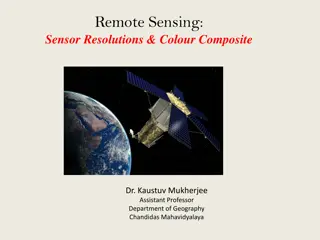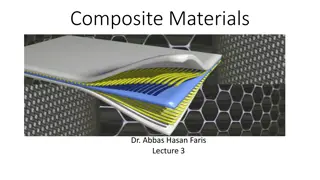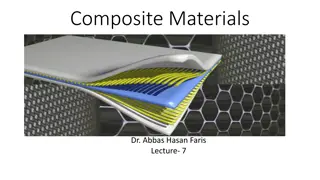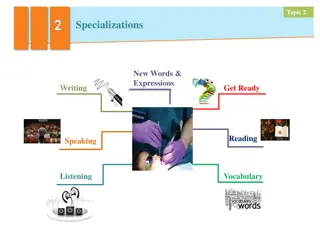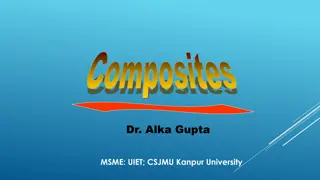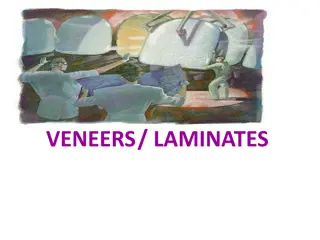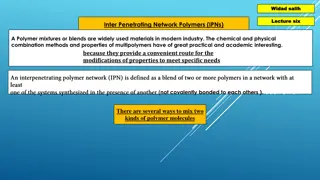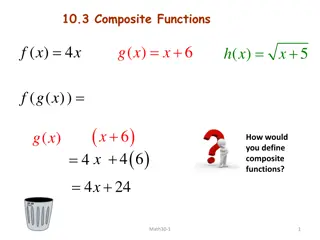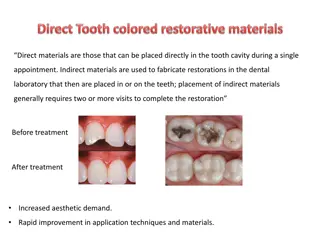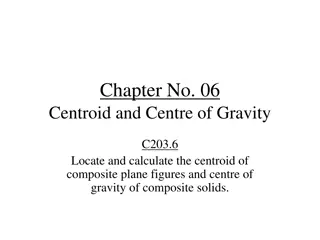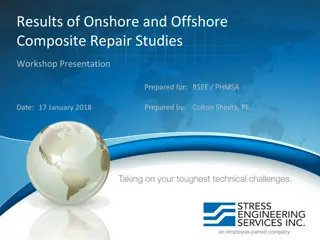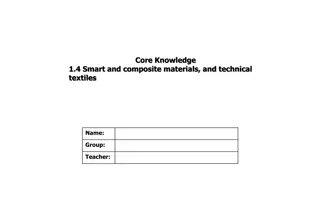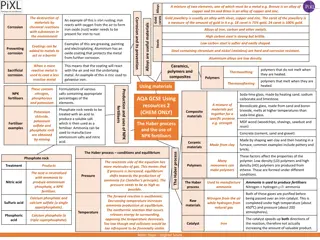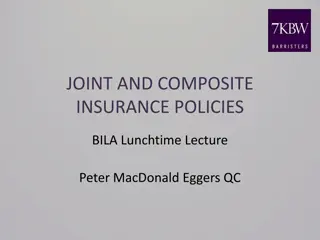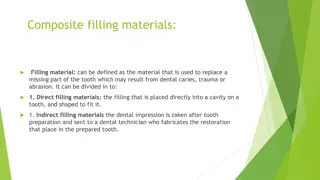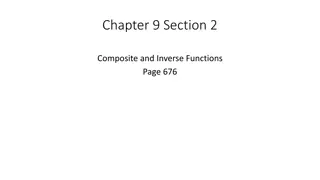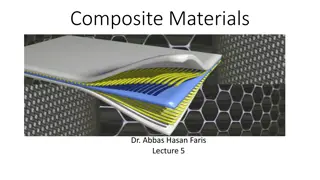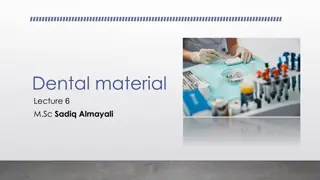Overview of Composite Materials in Dentistry
Composite materials used in dentistry can be categorized based on their curing mechanism and filler particle size. They include chemically activated, light activated, and dual cured composites. Chemically activated composites require two paste systems, while light activated composites use UV or visible light for activation. Dual cured composites combine light activation with self-curing capabilities. Each type offers specific advantages and drawbacks, impacting their applications in dental procedures.
Download Presentation

Please find below an Image/Link to download the presentation.
The content on the website is provided AS IS for your information and personal use only. It may not be sold, licensed, or shared on other websites without obtaining consent from the author.If you encounter any issues during the download, it is possible that the publisher has removed the file from their server.
You are allowed to download the files provided on this website for personal or commercial use, subject to the condition that they are used lawfully. All files are the property of their respective owners.
The content on the website is provided AS IS for your information and personal use only. It may not be sold, licensed, or shared on other websites without obtaining consent from the author.
E N D
Presentation Transcript
Types of composite Based on curing mechanism can be divided to: 1. Chemically activated composite or self cured composite. 2. Light activated composite. 3. Dual cured composite
Based on size of filler particles can be divided to: 1. Conventional or traditional composite. 2. Small particles composite. 3. Micro filled composite. 4. Hybrid composite. 5. Nanocomposites.
Chemically activated composite resins (self cured composite):This is two paste system (base and catalyst) two tubes. The base paste Contains benzyl peroxide initiator The Catalyst paste contains tertiary amine activator
Light activated composite resins: UV activated systems: The earliest system used Ultra Violet light. Not used now a day because of the Limited penetration of the light into the resin, Lack of penetration through tooth structure and it Irritant to the soft tissue. Visible Light activated resins: They are widely used than the chemically activated resins. These are single paste system containing Photo initiator 1) and Amine accelerator.
Under normal light they don't inter act but when exposed to light of the correct wave length the photo initiator is activated and reacts with amine to form free radical. In some cases inhibitors are added to enhance its stability to room light or dental operatory light. The properties of light cures composite are: 1. Supplied as single component (light tight syringes) or unit-dose capsules. 2. Working time under control of Operator. 3. More Homogenous mix 4. Required light of correct wave Length for its activation. 5. Cure only where sufficient Intensity of light is received. 6. Less chance of air entrapment during manipulation
Dual cured composite: This formulation contained an initiator and accelerator that allow light activation follow by self curing. It consists of two light-curable pastes, one containing benzoyl peroxide and the other containing an aromatic tertiary amine accelerator. The major advantage of this system is assurance of completion of cure. The major disadvantage is porosity caused by the required mixing. But this has been greatly alleviated by the use of mixing syringes. There is also less color stability than with the light cure resins due to the accelerators, but this is still better than for self-cure systems.
For Self- and Dual-Cured Composites, Mix equal amount of base and catalyst pastes thoroughly for 20 to 30 seconds use plastic or wooden spatulas (avoid metal spatulas because the inorganic filler particles are abrasive and small amounts of the metal can abraded and discolor the composite. Insertion: The composite can be inserted with a plastic instrument, which does not stick to the composite during insertion or It can be injected into the cavity preparation by a syringe
Classification based on size of filler particles 1.Conventional composite (Traditional or macrofilled composite): The early composites were macrofills, These composites contained large spherical or irregular shaped filler particles, There is a wide distribution of particle size of average filler diameter of 10 to 100 m, Filler loading is 70-80 wt % or 50-60 vol %. Ground quarts are most commonly used as filler.
The conventional composite have improved properties compared to unfilled restorative resin (acrylic) it has more compressive strength, tensile strength, elastic modulus and hardness, and it has less water sorption and low coefficient of thermal expansion. Although the conventional composite were superior to unfilled resin, they had certain disadvantages: 1. Surface finish was very poor and dull appearance (Polishing was difficult and results in a rough surface) this is due to selective wear of the softer resin matrix leaving the hard filler particles elevated. 2. Poor resistance to occlusal wear. 3. Tendency to discolor, the rough surface tends to stain.
2.Micro filled composite: They were developed to overcome the problems of surface roughness of conventional composite. The microfilled composite achieved the smoothness of unfilled acrylic direct filling resins and the advantages of having filler. The smoother surface is due to the incorporation of micro fillers, Colloidal silica is used as micro filler with size 0.01 to 0.1 m, Filler loading is 50 vol. wt %.
3.Small particles composite: Small particles composite were introduced in an attempt to have good surface smoothness (like microfilled composite) and yet retain or improve the physical and mechanical properties of conventional composite. The small particles composite use fillers that have been ground to smaller filler size about 0.1 10 m. Due to the higher filler content ( 65 to 77 vol. % or 80 to 90 wt. %) the best physical and mechanical properties are observed with this type. they can be used in areas of stress such as CI II and CI III restorations (Due to the improved strength and abrasion resistance). The filler employed are:
1. Glass containing heavy metals, Ground quartz is also used 2. Colloidal silica is also added in small amount. 5 wt % to adjust the paste viscosity.
4. Hybrid composite: - These were developed so as to obtain better surface smoothness than that of small particle, but yet maintain the properties of latter. The hybrid composites have a surface smoothness and esthetics competitive with microfilled composite for anterior restoration. Hybrid composites are formulated with mixed filler systems containing both microfine (0.01 to 0.1 m) and fine (0.1 to 10 m) particle fillers.
5.Nanocomposite/ Nanofillers :Nanofillers and Nanocomposites the latest advancement in composite technology has been the use of nanotechnology in development of fillers. Nanotechnology is the production of functional materials and structures in the range of 1 -100 nanometers (nm) by various physical and chemical methods. Manipulation of the composite: Composites used for restoring teeth are usually supplied in a kit containing the following: Syringes of composite resin paste in various shades.
Etching liquid (37% phosphoric acid). Enamel dentin bonding agent. Shade guide.
The manipulation is 1. pulpal protection: with cavity liner 2. Etching: the enamel at the cavity margins is acid etched with 37% phosphoric acid solution or gel for 30 seconds. Flush the acid away with water, and gently dry the surface with a stream of air. 3. Bonding agent an enamel and dentin bond agent is applied and polymerized that provides micromechanical retention of the restoration. The cavity is now ready for the composite. 4. dispensing: For light-Cured Composites, dispense small increments and pack into the cavity preparation, while controlled setting time allows for the individual polymerization of small increments of composite which help
in: A- Use of multiple shades of composite within a single restoration. B- Accommodating polymerization shrinkage within each increment
6. Polymerization: for light cure composite the exposure times vary from 20 to 60 seconds for a restoration 2 mm thick depending on the type of light-curing unit and the (type, depth, and shade) of the composite. for Self-Cured Composites: After mixing, a working (or insertion) time is 1 to 1.5 minutes then the mix will begin to harden, the setting time is about 4 to 5 minutes from the start of the mix. For Dual-Cured Composites: They contain chemical accelerators and light activators, so polymerization can be initiated by light and then continued by the self-cured mechanism. 7. Finishing and polishing.







